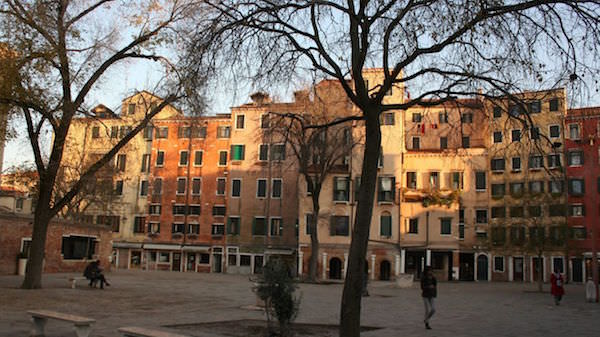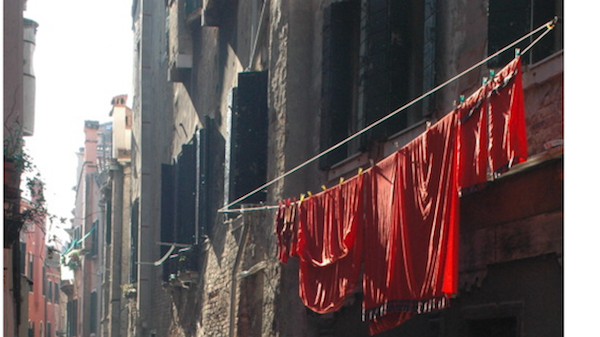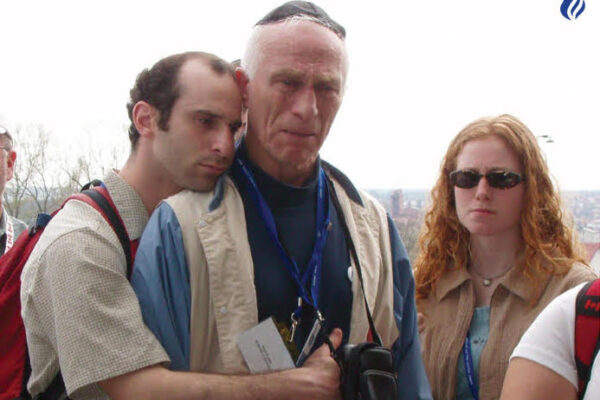
A 7-branched menorah stands out from the wall of a building in the Venetian ghetto. Credit: John W. Schulze, Flickr Creative Commons
Five hundred years ago, in the year 1516, the first official ghetto was established, in Venice.
It isn’t that Jews hadn’t lived in isolation in Europe’s cities before. They had, by choice. The nature of their religious observance requires Jews to live near a synagogue, a Jewish butcher, and Jewish ritual baths, among other specialized services. But the Venetian Ghetto was something new: It was obligatory, walled in, and the gateways were guarded by armed men who enforced a curfew.
From there, the practice of isolating the Jews in ghettoes would spread to other Italian cities, then throughout Europe during the 16th and 17th centuries. But the origin of the word “ghetto” itself is an etymological conundrum.
First recorded in a papal bull issued by Pope Pius IV in 1562, “ghetto” was subsequently used throughout Christendom. The pope was clearly using the already established name of the Venetian Ghetto, but the question still begs, why it was called “the Venetian Ghetto”. Of the many theories for the word’s emergence, none are satisfactory.
Some scholars think it derives from get, the Hebrew word for “divorce papers.” But it is hard to see how a word meaning divorce papers would gain wide currency as the name a “walled-off area of town where Jews live.”
Another explanation, probably the most cited one, is that the word comes from the Italian word getto (“foundry”). The theory is that the Venetian Ghetto was established on the site of an old foundry and thus took its name. But this etymology has a phonetic problem – getto is pronounced with a soft g (like in the English word “gin”), while ghetto is pronounced with a hard g (like the English word goat). A soft g is unlikely to turn into a hard one.
Another theory, perhaps the most plausible one, is that the word comes from the Italian word borghetto (“little town”). The main objection to this etymology is that it is general in usage and is not specific to “Jewish district.”
There are other even less plausible theories, so we’ll leave it at that. (For a more complete list of proposed etymologies and a detailed explanation of why they are unlikely, see Anatoly Liberman’s “Why Don’t We Know the Origin of the Word Ghetto?”). Now let’s see how the ghettoes of Europe morphed into phrases like “ghetto blaster”.
The main square of the 16th-century Venetian ghetto, then a walled-off area governed by curfew, where the Jews were forced to live. Moshe Gilad

The main square of the 16th-century Venetian ghetto, then a walled-off area governed by curfew, where the Jews were forced to live. Credit: Moshe Gilad
The Nazis revive the concept
Come the 18th and 19th centuries, as the Age of Enlightenment spread through Europe, the continent’s nations began to liberalize their treatment of Jews, and the walls around ghettos began to come down. By the beginning of the 20th century, ghettos seemed to be a thing of the past.
Then in the 1930s, the Nazis came to power in Germany.
Soon after invading Poland in 1939, the Nazis began establishing ghettos in Polish cities, in which they forced the Jews to live.
The first of these new ghettos was created in the Polish town Piotrków Trybunalski on October 8, 1939, a mere 38 days after the invasion of Poland began. More would follow, at first in Poland and later in other cities in Nazi occupied Europe.
These Nazi ghettos were small and inadequate to house the large numbers of Jews that were forced into them, resulting in squalid conditions. On average, for example, a room in the Warsaw Ghetto housed seven people.
Then in 1942, the Nazis began to liquidate the ghettos – by shipping their residents to extermination camps, where most of them were murdered. When World War II ended in 1945, the Jewish ghettos were no more.
However, the English word ghetto would live on, and take on a somewhat different nuance. No longer associated with Jews, ghetto came to mean an urban area where minorities live in poverty. The popularization of this word in this general sense is attributed to Israel Zangwill, a Jewish British author, and his book “Children of the Ghetto: A Study of a Peculiar People” (1892). Elvis Presley’s comeback hit “In the Ghetto” (1969) about the life of African Americans in southside Chicago is emblematic of the new use of the word.
Sheets hanging in the Venice ghetto, which was established in 1516 as a closed dwelling area for Jews.Bryan Ledgard, Flickr

Sheets hanging in the Venice ghetto, which was established in 1516 as a closed dwelling area for Jews. Credit: Bryan Ledgard, Flickr
Yet starting in the 1970s, use of the word ghetto began to decline in print, replaced by other less evocative terms such as “inner city.” Meanwhile, though, it began to gain currency in slang, with rappers singing about the ghetto as a source of pride. The word found its way into a variety of phrases such as “ghetto blaster” (1982), a portable cassette player, and “ghetto fabulous” (1996) a flashy and glitzy style associated with hip-hop culture. And an adjective was born, meaning “makeshift” or “jury-rigged” – or a person could be said to “be ghetto,” that is, act in low–class way.
Originally published HERE.







